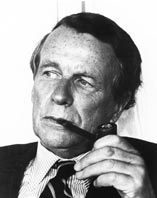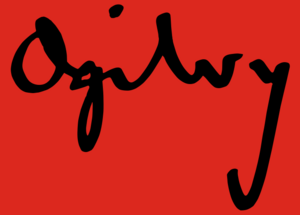Ogilvy (agency) facts for kids
 |
|
| Private | |
| Industry | Advertising, marketing, public relations |
| Founded | 1948 |
| Founder | David Ogilvy |
| Headquarters | |
|
Key people
|
Devika Bulchandani (Global chief executive officer), |
|
Number of employees
|
17,500 (2022) |
| Parent | WPP plc |
Ogilvy is a big company that helps other businesses with their advertising, marketing, and public relations. It started in London, England, way back in 1850. Later, in 1964, it joined forces with an agency in New York City that was started by a famous person named David Ogilvy.
Today, Ogilvy is part of a huge global network called WPP Group. They offer many services, like helping companies grow, creating ads, managing public image, and even working in healthcare marketing. They also have a special team called Ogilvy Consulting that helps with business plans.
Contents
History of Ogilvy
How it All Started
The company began in London in 1850. A man named Edmund Charles Mather opened an advertising agency. By the 1860s, he even had a branch in New York City. After Mather passed away, his son teamed up with Herbert Oakes Crowther, and the agency became Mather & Crowther.
This agency was a pioneer in newspaper advertising. They taught businesses how useful advertising could be. They even made "how-to" guides for the new advertising industry. The company became well-known in the 1920s for creating famous sayings like "an apple a day keeps the doctor away".
David Ogilvy Joins the Team
In 1921, Mather and Crowther hired Francis Ogilvy as a writer for ads. Francis later became the first person outside the family to lead the agency. He helped his younger brother, David Ogilvy, get a job selling a Swedish stove called the AGA cooker.
David was so good at selling the cooker that he wrote a sales guide in 1935. This guide was later called "probably the best sales manual ever written" by Fortune magazine.
David Ogilvy sent his sales guide to Francis, who then hired him as a trainee. David studied advertising, especially American campaigns, which he thought were the best. In 1938, David convinced Francis to send him to the United States to learn more about American advertising.
After a year, David shared 32 "basic rules of good advertising" with Mather & Crowther. For the next ten years, he worked in research and even for British Intelligence during World War II. He also spent some time farming with the Amish community.
Starting in New York City
In 1948, David Ogilvy suggested that Mather & Crowther and another UK agency should team up. They would create an American advertising agency in New York City. Both agencies invested money in this new idea.
David Ogilvy opened his New York agency on September 23, 1948. It was first called Hewitt, Ogilvy, Benson, & Mather. They started with a few small clients, like Wedgwood China and Guinness.
Their first big success was an ad for Guinness called "The Guinness Guide to Oysters." This ad showed different kinds of oysters and how they paired with Guinness. Soon after, they got a large client, Sunoco.
A major breakthrough happened with a shirt company called C. F. Hathaway Company. In 1951, they launched "The man in the Hathaway shirt" campaign. The ad featured a fancy man wearing an eyepatch. David Ogilvy bought the eyepatch on his way to the photo shoot to make the ad more interesting. This campaign made Hathaway shirts sell out quickly and boosted the company's sales by 160 percent. The "Hathaway Man" became a popular image.
Changes and Growth
Because of disagreements, David Ogilvy took over the agency in 1954. It was then renamed Ogilvy, Benson & Mather. During the 1950s, the agency became known for its successful campaigns.
Ogilvy believed that advertising should sell products by giving information and being convincing, not just by being entertaining. Their ads often used long descriptions, big photos, and clear designs.
In 1956, the agency almost doubled in size when they won the Shell Oil account. They agreed to work for Shell based on a fee, which was a new idea at the time for big advertising agencies.
Becoming Ogilvy & Mather
To handle more international advertising, Ogilvy, Benson & Mather joined with Mather & Crowther in 1964. They formed a new main company called Ogilvy & Mather, based in New York. In 1965, both agencies changed their names to Ogilvy & Mather.
In the 1970s, Ogilvy & Mather bought many other agencies. This helped them grow and offer new services, like direct-response advertising. David Ogilvy was worried that buying too many different agencies might change the company's special culture. In 1973, he moved to his French castle and stepped down as chairman.
The 1980s and WPP
In 1980, the agency started its public relations division, Ogilvy & Mather Public Relations. The next year, they became one of the first major agencies to offer interactive marketing services.
In 1989, a British advertising company called WPP plc bought the Ogilvy Group for a lot of money. David Ogilvy didn't want the company to be sold at first, but he later accepted an honorary role with WPP.
The 1990s: New Leaders and IBM
In 1992, Charlotte Beers became the chairman and CEO of Ogilvy & Mather Worldwide. She was the first woman to lead a major international advertising agency. She introduced the idea of "brand stewardship," which means building a brand's image carefully over time. She also helped the company get new business.
In 1994, Ogilvy & Mather won the huge global account for the technology company IBM. This was the biggest account change in advertising history at the time.
After Charlotte Beers, Shelly Lazarus became CEO in 1996 and chairman in 1997. She was the first woman to take over from another woman at a major agency. She developed the idea of "360-degree branding," which means making sure a brand's message is consistent everywhere people see it.
David Ogilvy passed away in July 1999 at his home in France.
The 2000s and Beyond
In 2009, Miles Young became the Worldwide CEO. He focused on making ads that were both creative and effective. Under his leadership, Ogilvy won many awards, including "Network of the Year" at the Cannes Lions International Festival of Creativity from 2011 to 2015.
In 2010, the agency created OgilvyRED, a special team for business strategy. They also merged some of their units with other companies to form new networks like Geometry Global.
Ogilvy continued to win many awards, including "Network of the Year" at the Cannes Lions International Festival of Creativity and Clio Awards for several years in a row. They were also named the "World's most Effective Agency Network" by Effies.
In 2016, John Seifert became the CEO. By 2018, Ogilvy had many different specialized units. For example, Ogilvy Public Relations handled public relations, and OgilvyOne focused on direct marketing.
To make things simpler, CEO John Seifert launched a "re-founding" in June 2018. The company changed its name from Ogilvy & Mather to just Ogilvy. They also brought most of their different units under one main Ogilvy brand. They kept their strategy division but renamed it Ogilvy Consulting.
In June 2020, Andy Main became the new CEO. He organized Ogilvy's services into five main areas: Advertising, Experience, Public Relations, Health, and Consulting.
In 2021, Ogilvy gained many new clients, including Absolut vodka, Enterprise Holdings (car rentals), and Coca-Cola. In September 2022, Devika Bulchandani took over as CEO. In 2022, they also started working with Audi of America.
In March 2024, Ogilvy announced that its customer experience services would be brought together under the Ogilvy One brand again.
Famous Ad Campaigns
Early Successes
One of Ogilvy's first big jobs was to introduce Guinness beer to Americans. In 1950, they created "The Guinness Guide to Oysters," which was a magazine ad listing different kinds of oysters. It was very successful.
In 1951, "The Man in the Hathaway Shirt" ad was published. It featured a man with an eyepatch and quickly boosted sales for the shirt company.
To help Americans get to know Schweppes drinks, Ogilvy created a spokesperson named Commander Whitehead in 1952. This campaign made Schweppes a very popular tonic drink in the country.
Ogilvy also helped Puerto Rico attract more businesses and tourists. They created ads with beautiful pictures to show the island as a paradise. This helped tourism to the UK triple.
In 1959, Ogilvy worked on an ad for Rolls-Royce cars. David Ogilvy spent weeks researching the car. The famous headline for the ad was: "At 60 miles an hour the loudest noise in this new Rolls-Royce comes from the electric clock." This ad became one of Ogilvy's most well-known.
Later Big Campaigns
American Express
Ogilvy & Mather worked with American Express since the 1960s. In 1974, they launched the "Do You Know Me" campaign. This campaign showed famous people who used the American Express card, emphasizing that the card itself was a sign of prestige.
Later, a campaign called "Portraits" featured celebrities like Ella Fitzgerald in their free time. This campaign was named "Print Campaign of the Decade" in 1990. In 2004, they launched the slogan "My Life. My Card." with stars like Ellen DeGeneres.
Merrill Lynch
In the late 1960s, Ogilvy & Mather started working with Merrill Lynch. In 1971, they suggested using a bull as a symbol for the company, which became the company's famous logo.
IBM
In 1994, Ogilvy & Mather became the only agency for all of IBM's marketing. They launched a worldwide campaign called "Solutions for a Small Planet" to help rebrand the company.
Incredible India
Ogilvy & Mather created the slogan "Incredible India" for India's Ministry of Tourism in 2002. This campaign aimed to attract more international tourists.
Dove
Dove has been an Ogilvy & Mather client since the 1950s. In 2004, the agency launched the Dove Campaign for Real Beauty. This campaign focused on showing different kinds of beauty and challenging old ideas. A short film called Sketches became incredibly popular online, with over 114 million views.
BP
In 2005, Ogilvy helped BP with an ad campaign that introduced the idea of a carbon footprint. This campaign suggested that individuals are responsible for climate change.
Rolls-Royce (Revisited)
Ogilvy's 1958 Rolls-Royce ad was special because it used a lot of detailed text. It focused on the car's engineering quality and luxury. The famous line highlighted how quiet the Rolls-Royce was, making a small detail a big reason to buy the car.
Inspiration for Mad Men
Ogilvy has been mentioned as a big inspiration for the fictional advertising agency in the TV show Mad Men. A long-time Ogilvy employee, Jane Maas, was said to be the inspiration for the character Peggy Olson.
Awards and Recognition
Ogilvy has won many awards over the years. In September 2020, they were named Network of the Year by Design and Art Direction (D&AD). They also won a top award for the Burger King "Moldy Whopper" campaign.
In June 2022 and June 2024, Ogilvy was named Network of the Year by the Cannes Lions International Festival of Creativity.
See also



